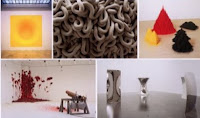 Well, I’ve been there, so I guess I’m not square but I’m not quite sure how I do shape up. Did I like it, did I think it was brilliant: was it too avant-guarde for me to understand? Is it a bit of fun, something to challenge my conceptions about what art should be or is it in fact all a bit of a con?
Well, I’ve been there, so I guess I’m not square but I’m not quite sure how I do shape up. Did I like it, did I think it was brilliant: was it too avant-guarde for me to understand? Is it a bit of fun, something to challenge my conceptions about what art should be or is it in fact all a bit of a con? Well, I think I now know where I am on Anish Kapoor. Yes, the exhibition is a piece of fun – well several pieces of fun actually – very colourful and kooky. The installations – because that’s what they are, produced to Kapoor’s design by a team of artistic craftsmen – are beautifully made and superbly finished. The ideas are great, the finished products skillful but…....
I liked his reflective shaped pieces - sorry, mirror-polished stainless-steel sculptures. The large rectangular concave/convex one is a great – so simple in form, so beautiful in finish. Set in a landscape (as it was shown on the TV) it mirrors the sky and the scenery in such a way that everything is better, bigger. It focuses ones mind on the movement of the clouds across the surface in a way that no-one would ever appreciate looking at the sky. Not without getting a terrible crick in the neck anyway.
Although…. I couldn’t but help think of the distorting mirrors in old-fashioned circuses and fun fairs. The ones where everyone stands there and says, Ooooh, Look at you all long and thin; Aaaah, Look at me as wide as a bus. Well these are a bit the same but different because these are ‘art’ of course. These are ‘stretching reality’. Those at the fun fair are just making you look very odd.
 But a big wax loaf of bread squeezing through an arch (Svayambh) – a bit shaved off every time it traverses it – and the cannon (Shooting into the Corner) splatting out a lump of dribbly wax every half an hour is all a bit playschool playdough. I think we got a handle on what that stuff’s all about by the time we were five.
But a big wax loaf of bread squeezing through an arch (Svayambh) – a bit shaved off every time it traverses it – and the cannon (Shooting into the Corner) splatting out a lump of dribbly wax every half an hour is all a bit playschool playdough. I think we got a handle on what that stuff’s all about by the time we were five. Then there are the worm casts. Again, little people will have no trouble with this one. They can be found down on their level on the wide expanses of wet sand at the seaside. The thought of a whole room of larger than life size ones would thrill them. They know all about wormy shapes and wiggly coils and building stuff from sand that sometimes collapses before it’s finished.
 But I guess I can see how he’s getting us to embrace colour: all enveloping colour. Colour that is powerful and pure, invigorating and intoxicating (his words). There’s lots of clear red and bright yellow. Primary stimulation as every baby of 5 months knows. We do seem to be afraid of colour these days, in our tastefully bland beige homes and all white gardens,wearing our toning grey grunge.
But I guess I can see how he’s getting us to embrace colour: all enveloping colour. Colour that is powerful and pure, invigorating and intoxicating (his words). There’s lots of clear red and bright yellow. Primary stimulation as every baby of 5 months knows. We do seem to be afraid of colour these days, in our tastefully bland beige homes and all white gardens,wearing our toning grey grunge. And I can just about swallow how he’s trying to get the visitor to think about space – that physical space that exists between the viewer and the thing that he’s viewing – how you’re not quite sure when you are here and when you have entered there.
I know I stood in front of his big yellow piece (creatively called, Yellow) and thought Wow, this is fabulous. It seems to go into (onto?) infinity: where did it end? one can stare at it, get lost in it – meditation nirvana. But that was about it.
Well, I thought, that was a not inexpensive visit to see an inspiring big yellow basin on its side and a lot of congealed red wax everywhere. Fortunately, I felt I had got my money's worth after all when I went upstairs to sexy sculptor Eric Gill.
Lucy
Lucyannwrtites.blogspot.com


